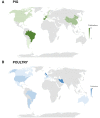Environmental Impacts of Pig and Poultry Production: Insights From a Systematic Review
- PMID: 34778435
- PMCID: PMC8578682
- DOI: 10.3389/fvets.2021.750733
Environmental Impacts of Pig and Poultry Production: Insights From a Systematic Review
Abstract
Pig and poultry production systems have reached high-performance levels over the last few decades. However, there is still room for improvement when it comes to their environmental sustainability. This issue is even more relevant due to the growing demand for food demand since this surplus food production needs to be met at an affordable cost with minimum impact on the environment. This study presents a systematic review of peer-reviewed manuscripts that investigated the environmental impacts associated with pig and poultry production. For this purpose, independent reviews were performed and two databases were constructed, one for each production system. Previous studies published in peer-reviewed journals were considered for the databases if the method of life cycle assessment (LCA) was applied to pig (pork meat) or poultry (broiler meat or table eggs) production to estimate at least the potential effects of climate change, measured as CO2-eq. Studies considering the cradle-to-farm gate were considered, as well as those evaluating processes up to the slaughterhouse or processor gate. The pig database comprised 55 studies, while 30 publications were selected for the poultry database. These studies confirmed feeding (which includes the crop cultivation phase, manufacturing processes, and transportation) as the main contributor to the environmental impact associated with pig and poultry production systems. Several studies evaluated feeding strategies, which were indicated as viable alternatives to mitigate the environmental footprint associated with both production chains. In this study, precision feeding techniques are highlighted given their applicability to modern pig and poultry farming. These novel feeding strategies are good examples of innovative strategies needed to break paradigms, improve resource-use efficiency, and effectively move the current productive scenario toward more sustainable livestock systems.
Keywords: broilers; climate change; environment; laying hens; livestock; precision feeding; sustainability; swine.
Copyright © 2021 Andretta, Hickmann, Remus, Franceschi, Mariani, Orso, Kipper, Létourneau-Montminy and Pomar.
Conflict of interest statement
The authors declare that the research was conducted in the absence of any commercial or financial relationships that could be construed as a potential conflict of interest.
Figures





References
-
- Simmons J. Making safe, affordable and abundant food a global reality. Range Beef Cow Symposium. Lincoln (2011).
-
- McAuliffe GA, Chapman DV, Sage CL. A thematic review of life cycle assessment (LCA) applied to pig production. Environ Impact Assess Rev. (2016) 56:12–22. 10.1016/j.eiar.2015.08.008 - DOI
-
- Lovatto PA, Hauschild L, Hauptli L, Lehnen CR, Carvalho Ad'A. Modelagem da ingestão, retenção e excreção de nitrogênio e fósforo pela suinocultura Brasileira. J Rev Bras Zootecn. (2005) 34:2348–54. 10.1590/S1516-35982005000700022 - DOI
-
- Basset-Mens C, van der Werf HMG. Scenario-based environmental assessment of farming systems: the case of pig production in France. Agric Ecosyst Environ. (2005) 105:127–44. 10.1016/j.agee.2004.05.007 - DOI
Publication types
LinkOut - more resources
Full Text Sources
Research Materials
Miscellaneous

